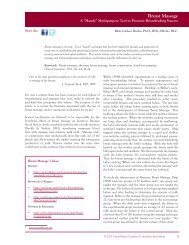Official Journal of the United States Lactation ... - Clinical Lactation
Official Journal of the United States Lactation ... - Clinical Lactation
Official Journal of the United States Lactation ... - Clinical Lactation
You also want an ePaper? Increase the reach of your titles
YUMPU automatically turns print PDFs into web optimized ePapers that Google loves.
Working with Families <strong>of</strong> Different Cultures I<br />
Lessons Learned<br />
Share this:<br />
Jeanette Panchula BSW, RN, PHN, IBCLC, RLC 1<br />
The Code <strong>of</strong> Pr<strong>of</strong>essional Conduct for IBCLCs states that an IBCLC must “Provide care to<br />
meet clients’ individual needs that is culturally appropriate and informed by <strong>the</strong> best available<br />
evidence.” IBCLCs must not only have knowledge that will help a mo<strong>the</strong>r breastfeed. They must<br />
also have <strong>the</strong> skill to help her to discern <strong>the</strong> best solution for her situation. The ability to communicate<br />
with clients does not necessarily mean learning “everything <strong>the</strong>re is to know” about<br />
<strong>the</strong>ir culture. Ra<strong>the</strong>r, it means learning <strong>the</strong> basis for <strong>the</strong> mo<strong>the</strong>rs’ beliefs and actions.<br />
Keywords: Breastfeeding support, ethnic-group differences, cultural competence<br />
<strong>Clinical</strong> <strong>Lactation</strong>, 2012, Vol. 3-1, 13-15<br />
Looking back on 26 years as an IBCLC, and 36 years as<br />
a La Leche League Leader, I cannot imagine a more exciting,<br />
awe-inspiring, frustrating, and worthwhile career. I<br />
was raised in a multigenerational, bicultural, and bilingual<br />
household and city, San Juan, Puerto Rico. In San<br />
Juan, people <strong>of</strong> many different socioeconomic groups<br />
mixed in <strong>the</strong> market, <strong>the</strong> stores, and schools. As a result,<br />
I have always been comfortable with a variety <strong>of</strong> accents,<br />
beliefs, and ways <strong>of</strong> life.<br />
The concept that <strong>the</strong>re is only one way—<strong>the</strong> way “I” was<br />
raised—was truly never expressed or taught to me.<br />
In fact, as a small child, I asked a nice man who was walking<br />
right by my porch: “¿Por qué tu eres tan negro”<br />
[Why are you so black]. Without missing a beat, he<br />
answered: “Porque estoy mucho al sol.” [Because I am in <strong>the</strong><br />
sun a lot.]<br />
That was <strong>the</strong> only education I received about race or<br />
skin color, as my parents did not believe it was an<br />
issue that I needed to be concerned with. It was only<br />
when a TV arrived in my home, and I saw horrible<br />
actions <strong>of</strong> o<strong>the</strong>rs in <strong>the</strong> sou<strong>the</strong>rn areas <strong>of</strong> <strong>the</strong> U.S. that I<br />
learned why my fa<strong>the</strong>r would not move back to <strong>the</strong><br />
U.S. with his dark-skinned Puerto Rican wife, and<br />
very light‐skinned (unless I spent a lot <strong>of</strong> time in <strong>the</strong> sun)<br />
daughter.<br />
When I lived in St. Louis in <strong>the</strong> 80s with my own children,<br />
husband, and mo<strong>the</strong>r (she lived with us for 25<br />
years)—I did experience how sales clerks and o<strong>the</strong>rs<br />
“assumed” my mo<strong>the</strong>r was my maid. This preface is an<br />
explanation <strong>of</strong> why and how I arrived at <strong>the</strong> philosophy<br />
1 jeanette.panchula@sbcglobal.net<br />
that I continue to practice today: All humans are different.<br />
All humans have <strong>the</strong>ir own story to tell. You cannot<br />
look at <strong>the</strong>m and assume you know anything about <strong>the</strong>m.<br />
You have to ask.<br />
Assumption: Fa<strong>the</strong>r is not involved/<br />
interested.<br />
You go into a hospital room, and you see a mo<strong>the</strong>r in<br />
<strong>the</strong> bed trying to breastfeed. She has a scarf over her<br />
head, keeping <strong>the</strong> hair out <strong>of</strong> her eyes as she works, and<br />
works at trying to get <strong>the</strong> baby on “right.” She is frustrated<br />
and worried. Her husband is on <strong>the</strong> o<strong>the</strong>r side <strong>of</strong><br />
<strong>the</strong> curtain, at times reading a book, at times speaking to<br />
her, urging her to “try this” or “try that.” Then he goes<br />
back to reading.<br />
Fact: Mom and dad are practicing orthodox Jews. Her<br />
head is covered as she should during <strong>the</strong> period that she<br />
is bleeding. She is untouchable at this time, and her husband<br />
is following strictly <strong>the</strong> instructions that he must<br />
not look at his wife’s body during this time.<br />
Actions: I stand in a location that allows both mo<strong>the</strong>r<br />
and fa<strong>the</strong>r to see me. I use a doll to demonstrate positioning<br />
to both (this is prior to Biological Nurturing®).<br />
We <strong>the</strong>n discuss how <strong>the</strong> fa<strong>the</strong>r can help his wife by<br />
identifying where she can sit and be comfortable, what<br />
pillows she may need, what foods are comforting to her,<br />
and how to burp and change <strong>the</strong> baby. He was so relieved<br />
to know that he could do something instead <strong>of</strong> being<br />
vilified as an uninterested or demanding jerk.<br />
How did we get <strong>the</strong>re By my asking: Can you tell me<br />
what you need What are your concerns What help will<br />
© 2012 <strong>United</strong> <strong>States</strong> <strong>Lactation</strong> Consultant Association 13




